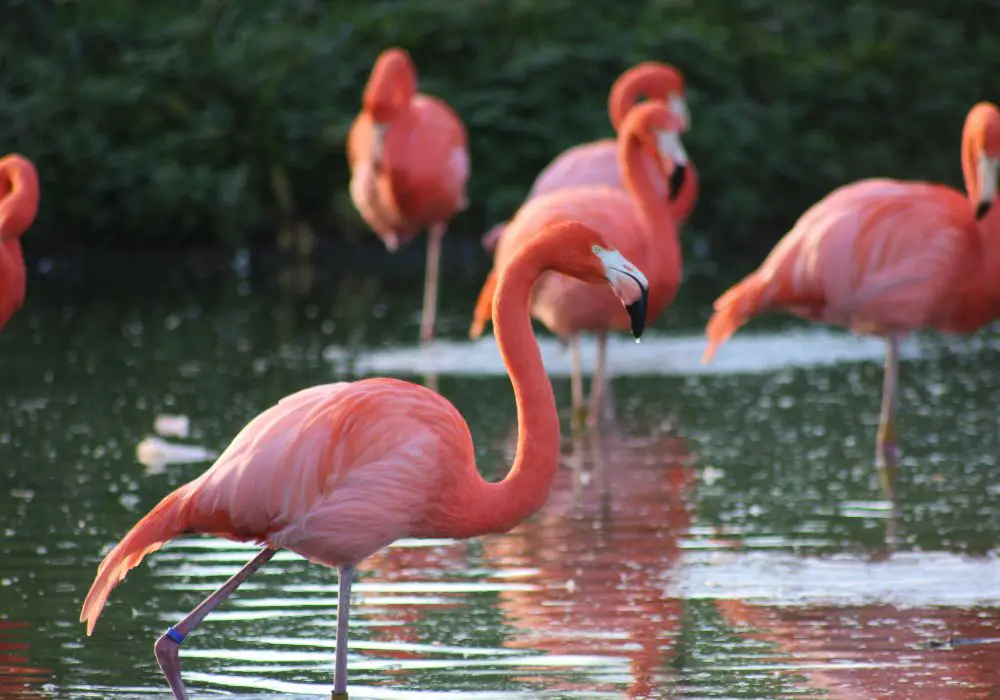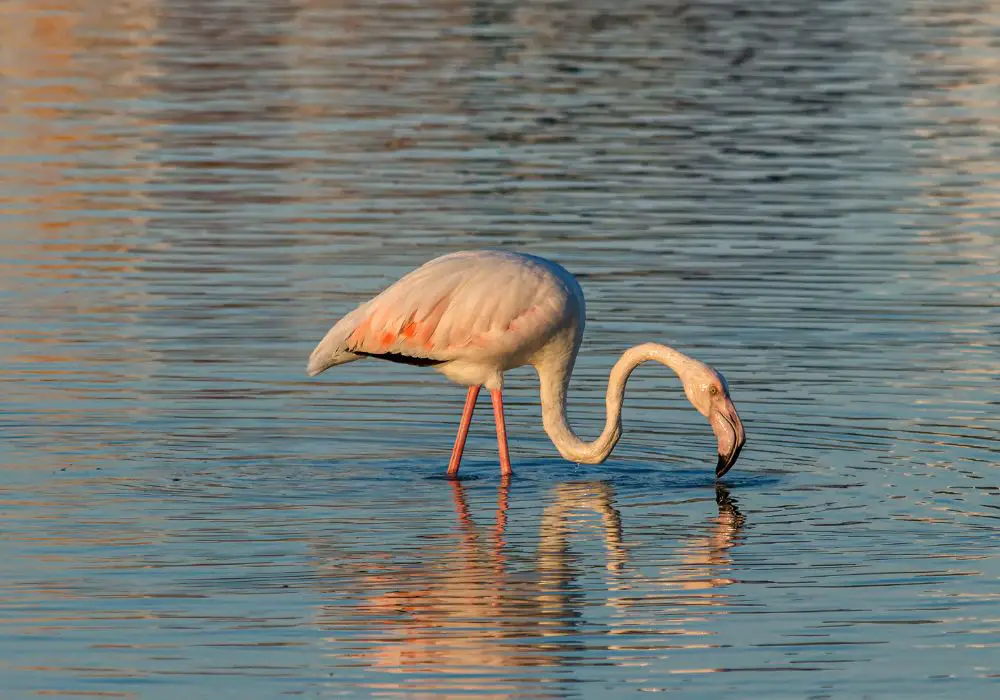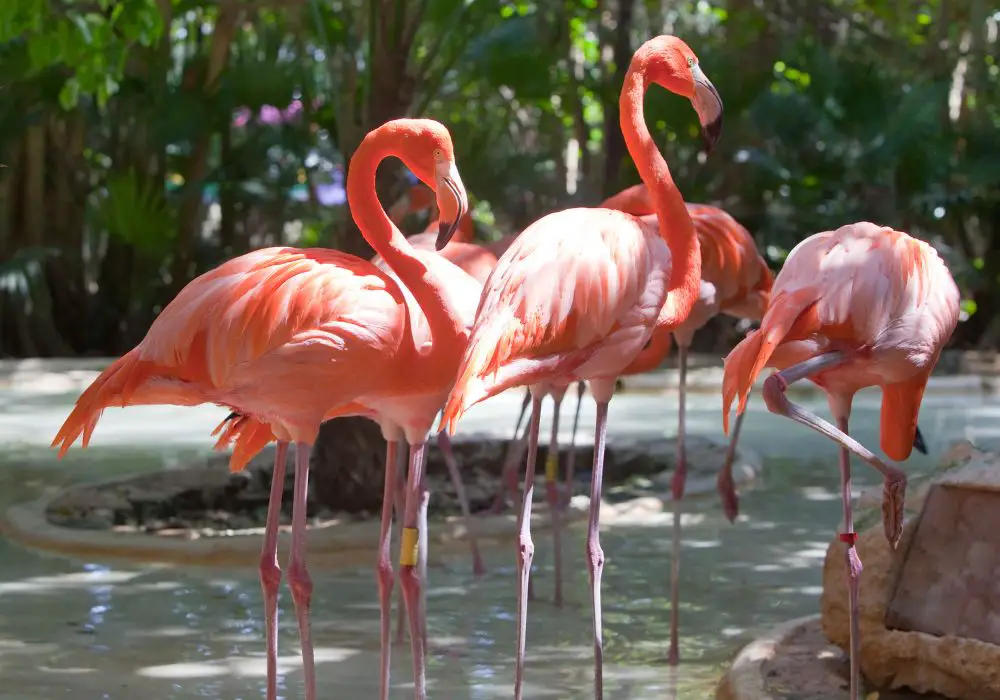Are you curious about whether flamingos have teeth? It’s a common question, and the answer might surprise you. Flamingos, like all birds, do not have teeth. Instead, they have a unique adaptation in their beaks that allows them to filter and crush their food.
Flamingos are known for their distinctive pink color and long, thin legs. They are also famous for their unique beaks, which are specially adapted to their diet. Flamingos are filter feeders, meaning they use their beaks to sift through water and mud for small organisms like algae, crustaceans, and insects. Their beaks are lined with tiny structures called lamellae, which act like filters to trap food particles while allowing water to flow out. Once the food is trapped, flamingos use their beaks to crush it into smaller pieces that can be easily digested.
Flamingo Anatomy

Flamingos are known for their unique appearance, with their long legs, pink feathers, and distinctive beaks. But what about their anatomy? Let’s take a closer look.
Beak Structure
The beak of a flamingo is a fascinating structure that is perfectly adapted to the bird’s feeding habits. It is long, thin, and curved, with a distinctive downward bend at the tip. The beak is made up of two parts, the upper mandible and the lower mandible, which are hinged together at the base.
One of the most interesting features of the flamingo’s beak is the presence of lamellae, which are small, comb-like structures that line the inside of the beak. These lamellae help the flamingo filter food from the water. As the bird scoops up water and mud with its beak, it closes its mouth and uses its tongue to push the water out through the sides of the beak, while trapping small particles of food on the lamellae.
The number and size of the lamellae varies depending on the species of flamingo. For example, the Andean flamingo has about 9 lamellae per cm (23 per in.), while the James’ flamingo has about 21 lamellae per cm (53 per in.). The Chilean flamingo has about 5 to 6 lamellae per cm (13-15 per in.).
Another interesting feature of the flamingo’s beak is the deep, narrow trough-like lower mandible, which allows them to eat small foods such as algae and diatoms. The bill of a flamingo is also designed specifically so that it opens and closes tightly and fits together snugly so that the birds can easily scoop potential food from the bottom of a lagoon or mudflat.
In addition to their beaks, flamingos also have unique feet that are perfectly adapted to their aquatic lifestyle. Their feet are webbed, with three toes pointing forward and one toe pointing backward. This allows them to walk on soft mud and swim through shallow water with ease.
Eating Habits of Flamingos

Flamingos are known for their unique feeding habits, which are shaped by the structure of their beaks. The shape of a flamingo’s filtering bill determines its diet. Lesser, James’, and Andean flamingos have deep-keeled bills and feed mainly on algae and diatoms. Greater, Caribbean, and Chilean flamingos have shallow-keeled bills and feed on insects, aquatic invertebrates, and small fishes.
Filter Feeding Method
Flamingos are filter feeders, which means they use their beaks to filter food from water or mud. Their beaks are specifically designed for this purpose, with a series of comb-like structures called lamellae that line the inside of their beaks. The lamellae act like filters, trapping small particles of food while allowing water to pass through.
When feeding, flamingos will often stand in shallow water and sweep their beaks back and forth through the water, filtering out small organisms like crustaceans, algae, and insect larvae. They may also use their beaks to stir up mud and silt at the bottom of a body of water, filtering out food particles in the process.
Diet
Flamingos have a varied diet that includes both plant and animal matter. Their diet is largely determined by the availability of food in their environment. In some areas, they may feed primarily on algae and diatoms, while in others they may feed on insects, crustaceans, and small fish.
One of the most interesting things about flamingos is their ability to extract nutrients from food sources that may not be very nutritious. For example, flamingos are able to extract nutrients from blue-green algae, which is not a very nutrient-dense food source. They do this by consuming large quantities of the algae and using their highly efficient digestive system to extract as many nutrients as possible.
Overall, flamingos are fascinating creatures with unique feeding habits and dietary needs. Their specialized beaks and digestive systems allow them to thrive in a variety of environments and make the most of whatever food sources are available to them.
Comparison to Other Birds
Flamingos Vs Ducks
When it comes to comparing flamingos and ducks, the most significant difference is in their beaks. Flamingos have long, slender beaks that are designed for filtering food from the water, while ducks have shorter, wider beaks that are better suited for catching and holding onto food. Flamingos also have longer legs compared to ducks, which allows them to wade in deeper water.
Another notable difference is in their coloration. Flamingos are known for their striking pink color, while ducks come in a variety of colors depending on the species. Additionally, flamingos are much larger than most duck species, with an average height of around 3 to 5 feet, while ducks are typically much smaller.
Flamingos Vs Penguins
While flamingos and penguins are both birds that are adapted to living in aquatic environments, there are several key differences between them. One of the most obvious differences is in their physical appearance. Flamingos have long, slender legs and necks, while penguins have short, stubby legs and a more rounded body shape.
Another significant difference is in their habitats. Flamingos are typically found in warm, tropical climates, while penguins are found in colder environments like Antarctica. Flamingos are also filter feeders, using their specialized beaks to strain food from the water, while penguins are carnivorous and hunt for their food.
When it comes to behavior, flamingos are known for their social nature and often gather in large flocks, while penguins tend to live in smaller groups or pairs. Penguins are also known for their unique ability to “toboggan” on their bellies across the ice, which is not a behavior seen in flamingos.
Overall, while both flamingos and penguins are adapted to living in aquatic environments, they have evolved very different physical and behavioral adaptations to suit their respective habitats and lifestyles.
Misconceptions About Flamingos

Teeth Myth
One of the most common misconceptions about flamingos is that they have teeth. This myth likely comes from the fact that flamingos have a beak that looks like it could have teeth. However, flamingos do not have teeth, as they are birds and birds do not have teeth.
Instead of teeth, flamingos have a specialized beak that allows them to filter food from water. Their beak is shaped like a spoon and has tiny bristles called lamellae on the inside. The lamellae act like a sieve, allowing the flamingo to filter out small organisms like algae and crustaceans from the water.
Another adaptation that flamingos have to help them eat is their tongue. Unlike most birds, flamingos have a muscular tongue that they use to pump water in and out of their beak. This helps them filter out food from the water more efficiently.
Overall, while flamingos may look like they have teeth, they do not. Instead, they have a specialized beak and tongue that allow them to filter food from water.
Frequently Asked Questions
What do flamingos use to eat?
Flamingos do not have teeth, but they have a unique beak that helps them to filter food from the water. Their beak is designed to filter out small organisms like shrimp, algae, and other tiny creatures from the water. They use their tongue to create a suction force that draws water and food into their beak.
What is the color of flamingos?
Flamingos are known for their bright pink color. The pink color of flamingos is due to the pigments in the algae and crustaceans that they eat. The more they eat these pigmented foods, the brighter their feathers become.
What do flamingos eat that make them pink?
Flamingos eat a variety of foods, including algae, shrimp, and crustaceans. The pigments in these foods contain carotenoids, which are responsible for the pink color of flamingos. The more carotenoids they consume, the brighter their feathers become.
How do flamingos eat without teeth?
Flamingos do not have teeth, but they have a unique beak that is designed to filter small organisms from the water. They use their tongue to create a suction force that draws water and food into their beak. Once the food is in their beak, they use their tongue to push the water out and swallow the food.
How many teeth does a flamingo have?
Flamingos do not have teeth. They have a beak that is designed to filter small organisms from the water.
What are some interesting facts about flamingos?
- Flamingos are social birds and live in large flocks.
- They are excellent swimmers and can swim up to 35 miles per hour.
- Flamingos can stand on one leg for hours at a time.
- They are monogamous and mate for life.
- Flamingos are found in parts of Africa, South America, and the Caribbean.






